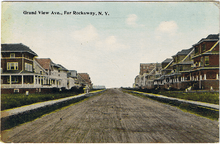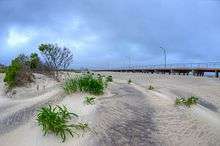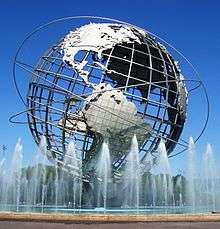Far Rockaway, Queens
| Far Rockaway | |
|---|---|
| Neighborhood of Queens | |
|
Far Rockaway street scene | |
| Country | United States |
| State | New York |
| City | New York City |
| County/Borough | Queens |
| Named for | Place name of the Native American Lenape. |
| Population (2010) | |
| • Total | 60,035 |
| Ethnicity | |
| • White | 31.0% |
| • Black | 50.1% |
| • Hispanic | 25.2% |
| • Asian | 2.0% |
| • Other | 14.3% |
| Economics | |
| • Median income | $27,820 |
| ZIP code | 11691 |
| Area code(s) | 718, 347, 917 |
Far Rockaway is a neighborhood on the Rockaway Peninsula in the New York City borough of Queens in the United States. It is the easternmost section of the Rockaways. The neighborhood starts at the Nassau County line and extends west to Beach 32nd Street. The neighborhood is part of Queens Community Board 14.[1]
History

The name "Rockaway" may have meant "place of sands" in the Munsee language of the Native American Lenape. Other spellings include Requarkie, Rechouwakie, Rechaweygh, Rechquaakie and Reckowacky.[note 1]
In September 1609, Henry Hudson and his crew were the first Europeans to see the Rockaways and Jamaica Bay.[2] Hudson was attempting to go to the Northwest Passage. On September 11, Hudson sailed into the Upper New York Bay,[3] and the following day began a journey up the modern-day Hudson River.
Rockaway was, back then, inhabited by Canarsie Indians. The name Reckowacky, which is also spelled Requarkie, Rechouwakie, Rechaweygh, or Rechquaakie,[note 1] was to distinguish the Rockaway village from other Mohawk Nation villages; "Reckowacky" means "lonely place", or "place of waters bright".[4] By 1639, the Mohegan tribe sold most of the Rockaways to the Dutch West India Company. In 1664, the English got the land from the Dutch.[note 2][5] In 1685, the tribal chieftain, Chief Tackapoucha, and the English governor agreed to sell the Rockaways to one Captain Palmer for 31 pounds sterling.[2]
The Rockaway Peninsula was originally part of the Town of Hempstead, then a part of Queens County. Palmer and the town of Hempstead disputed over who owned Rockaway, so the land was sold to Richard Cornell, an iron master from Flushing in 1687. Cornell and his family lived on a homestead on Central Avenue, near the Atlantic Ocean shore; upon his death, Cornell was buried in a small family cemetery, Cornell Cemetery, which is the only designated New York City landmark in the Rockaways.[2] The Rockaway Association wanted to build a hotel on the Rockaway peninsula. The association, consisting of many wealthy members, bought most of Cornell's old homestead property. The Marine Hotel, which was built on that site, became a place where the Vanderbilt family, Henry Wadsworth Longfellow, and Washington Irving, eventually stayed. The Rockaway Association also built the Rockaway Turnpike. The Marine Hotel burned to the ground in 1864, but more hotels and private residences were built in the area.[2]
Horse-drawn carriages and horses originally comprised a transport mode to the Rockaways. A ferry traveled from Lower Manhattan to Brooklyn. By the 1880s, the Long Island Rail Road's Rockaway Beach Branch was built from Far Rockaway station.[2] The steam railroad went to Long Island City and Flatbush Terminal (now Atlantic Terminal), which facilitated population growth on the Rockaway Peninsula when it opened in the 1880s.[6] Benjamin Mott gave the LIRR 7 acres (2.8 ha) of land for a railroad depot. Land values increased and businesses in the area grew, and by 1888, Far Rockaway was a relatively large village.[2] It incorporated as a village on September 19 of that year.[7]
By 1898, the area was incorporated into the Greater City of New York. Far Rockaway, Hammels, and Arverne tried to secede from the city several times. In 1915 and 1917, a bill approving the secession passed in the legislature but was vetoed by the mayor at the time, John Purroy Mitchel.[8]
In addition to the Far Rockaway Beach Bungalow Historic District, the Russell Sage Memorial Church, Trinity Chapel, and United States Post Office are listed on the National Register of Historic Places.[9]
Bungalows

The nearby beach made Far Rockaway an attractive destination for tourists and vacationers from the other boroughs. Bungalows were the homes of choice for many residents of the community who lived in Far Rockaway. The popularity of the resort suffered after the railroad abandoned the Rockaway Beach Branch in 1950, and by the increase in automobile ownership, followed by air travel, which opened up distant destinations to large numbers . As the neighborhood's heyday as a resort community declined in the 1950s, substantial numbers of public housing developments were built. Much of the housing was converted into year-round housing for low-income residents, and some bungalows used as public housing.[10][11] The 1970s New York City budget crisis had a negative impact on social services.[12] which negatively affected the Far Rockaway.
The Beachside Bungalow Preservation Association was created in September 1984, to "improve the quality of the Far Rockaway community through preservation, education, and cultural programs." "[13]
A collection of materials highlighingt the history, correspondence, and activities of the organization was donated to the Queens Library Archives in 2008.
Transportation

Far Rockaway is served by the following transportation services:
- The New York City Subway's IND Rockaway Line (A train), which has a terminal at Mott Avenue.[14][15]
- The Far Rockaway terminal station for the Long Island Rail Road's Far Rockaway Branch.[14] The branch had originally been part of a loop that traveled along the existing route, continuing through the Rockaway Peninsula and heading on a trestle across Jamaica Bay through Queens where it reconnected with other branches. Frequent fires and maintenance problems led the LIRR to abandon the Queens portion of the route, which was acquired by the city to become the IND Rockaway Line.[16]
- MTA Regional Bus Operations: Q22, Q113, Q114, QM17[14][17]
- Nassau Inter-County Express: N31, N32, N33.[14][17] Unlike other NICE routes in Queens, these buses operate open-door in Far Rockaway, meaning customers can ride these buses wholly within the neighborhood without necessarily going to Nassau County.
- NYC Beach Bus. A shuttle bus between downtown Brooklyn or Williamsburg and the area around Beach 84 and Jacob Riis Park.
Parks
Education and library
The neighborhood, like all of New York City, is served by the New York City Department of Education. Far Rockaway residents are zoned to several different elementary schools:
- P.S. 43
- P.S. 104 The Bayswater School
- P.S. 105 The Bay School
- P.S. 106
- P.S. 197 The Ocean School
- P.S. 215 Lucretia Mott
- P.S. 253
Far Rockaway residents are zoned to I.S. 53 Brian Piccolo.
All New York City residents who wish to attend a public high school must apply to high schools. Far Rockaway High School was located in Far Rockaway, but was shut down in 2011. Beach Channel High School is near Far Rockaway.
Church of God Christian Academy is a K–12 co-ed school, located on Central Avenue.
Nikitas Language Abroad Schools, a series of language schools, is also located in Far Rockaway.
A library is planned for the neighborhood, to be built by internationally known architectural firm Snøhetta.[18]
Jewish institutions
|
Schools (past and present):
|
Synagogues (past and present):
|
Notable people
- Richard Bey (born 1951), talk show host; went to Far Rockaway High School.[19]
- Baruch Samuel Blumberg (1925–2011), winner of 1976 Nobel Prize in Medicine; graduated from Far Rockaway High School in 1942.[20]
- Joyce Brothers (1925–2013), family psychologist and advice columnist; grew up in Far Rockaway.[21]
- Chinx (1983–2015), rapper, grew up in both the Redfern Houses and Edgemere Houses (the latter of which is now known as Ocean Bay Apartments).[22]
- Mac DeMarco (born 1990), Canadian songwriter and musician; has a house in Far Rockaway, where his album Another One was recorded.[23]
- Richard Feynman (1918–1988), physicist and Nobel Prize winner; grew up in Far Rockaway and graduated from Far Rockaway High School.[20][24]
- Carl Icahn (born 1936), businessman and philanthropist; grew up in Far Rockaway and went to Far Rockaway High School.[20][25]
- Nancy Lieberman (born 1958), women's basketball pioneer; grew up in Far Rockaway[26][27]
- Bernard Madoff (born 1938), former American stockbroker, investment advisor, and financier who was convicted of fraud; went to Far Rockaway High School.[28]
- Steve Madden (born 1958), shoe designer and former CEO of Steve Madden Ltd; born in Far Rockaway.[29]
- Alice Nielsen (1872–1943), Broadway performer and operatic soprano; owned a house in Far Rockaway in the 1920s.[30]
- Rammellzee (1960–2010), rap pioneer; born and died in Far Rockaway.[31]
- Burton Richter (born 1931), winner of 1976 Nobel Prize in Physics; graduated from Far Rockaway High School in 1948.[32]
- MC Serch (born 1967 as Michael Berrin), former member of the hip hop group 3rd Bass; grew up in Far Rockaway.[33]
- Raymond Smullyan (born 1919), mathematician; grew up in Far Rockaway.[34]
- Herbert Sturhahn (1902–1979), football player elected to the College Football Hall of Fame; born in Far Rockaway.[35]
Notes
- 1 2 See Metoac#Exonyms and Toponymy of New Netherland.
- ↑ See New Amsterdam
References
- ↑ Queens Community Boards, New York City. Accessed September 3, 2007.
- 1 2 3 4 5 6
- "Rockaway... 'place of waters bright'", rockawave.com. Retrieved 2015-03-16.
- "The Dean Georges Collection: Far Rockaway, Edgemer, Arverne". Rockaway Memories. Retrieved 2015-03-16.
- ↑ Nevius, Michelle and James, "New York's many 9/11 anniversaries: the Staten Island Peace Conference", Inside the Apple: A Streetwise History of New York City, 2008-09-08. Retrieved 2009-05-31.
- ↑ Rockaway, The Playground of New York, Annual yearbook of the Rockaways, June, 1934
- ↑ Henry L. Schoolcraft, "The Capture of New Amsterdam," English Historical Review (1907) 22#88 674–693 in JSTOR
- ↑ Jackson, Kenneth T., ed. (1995), The Encyclopedia of New York City, New Haven: Yale University Press, ISBN 0300055366, p. 120.
- ↑ Documents of the Senate of the State of New York, Volume 8, p. 9. New Jersey Legislature, 1913. Accessed July 26, 2016.
- ↑ "The Rockaways". Rootsweb.com. Retrieved December 6, 2006.
- ↑ National Park Service (2010-07-09). "National Register Information System". National Register of Historic Places. National Park Service.
- ↑ "Beach Bungalow Historic District" (PDF). National Register of Historic Places Registration Form. National Park Service. 2013. Retrieved November 22, 2013.
- ↑ Wilson, Charles (16 March 2012). "The Subway-Accessible, Surf-Ready, Urban Beach Paradise". New York Times Magazine. Retrieved 8 December 2013.
- ↑ "Fiscal crisis in 1975 taught New York hard lessons of chopping, freezing that are handy now". Daily News. New York.
- ↑ Autz, Lisa. "Far Rock Man Stands Up for Bungalows". TimesLedger Newspapers. Community Newspaper Group. Retrieved 6 December 2013.
- 1 2 3 4 "MTA Neighborhood Maps: Rockaways" (PDF). mta.info. Metropolitan Transportation Authority. 2015. Retrieved 25 November 2015.
- ↑ "Subway Map" (PDF). Metropolitan Transportation Authority. November 2016. Retrieved 2016-11-07.
- ↑ IND Rockaway Branch/Jamaica Bay Crossing, accessed June 14, 2006.
- 1 2 Queens Bus Map
- ↑ "Approval Matrix". New York magazine. Sep 30, 2013.
- ↑ Morales, Tina (1990-02-25). "SCHOOL OF THE WEEK/Far Rockaway High School". Newsday - The Long Island and New York City News Source. ProQuest Archiver. Retrieved 2015-11-25. (subscription required (help)).
- 1 2 3 "The Best Queens Celebrities 2002", Queens Tribune. Accessed November 25, 2015.
- ↑ "Dr. Joyce Brothers: Television and Radio Writer, Producer, Host". The Paley Center For Media. Retrieved 2015-11-25.
The daughter of lawyers, Joyce Diane Bauer was born in Manhattan and raised in Far Rockaway, Queens.
- ↑ "The Break Presents: Chinx Drugz". Xxlmag.com. 2012-02-17. Retrieved 2013-10-01.
- ↑ "Video // Mac DeMarco Announces New Mini LP + Tour Dates". Captured Tracks. April 22, 2015. Retrieved April 23, 2015.
- ↑ "Richard Phillips Feynman Facts, information, pictures". Encyclopedia.com. 2010-06-10. Retrieved 2015-11-26.
- ↑ Crowe, Portia (2015-05-04). "Carl Icahn told a story about his dad that always makes him tear up". Business Insider. Retrieved 2015-11-26.
- ↑ "Nancy Lieberman player profile". ODU Sports. Old Dominion University. Retrieved 2015-11-25.
On May 6, 2000, the Far Rockaway, NY native earned her degree from Old Dominion University in interdisciplinary studies.
- ↑ "Lieberman, Nancy". Encyclopedia.com. 1996-05-06. Retrieved 2015-11-25.
- ↑ Carney, John (2008-12-22). "The Education of Bernie Madoff: The High School Years". Business Insider. Retrieved 2015-11-25.
- ↑ Dominguez, Robert (2006-10-19). "BRINGING IT BACK HOME. Steve Madden's new ad campaign focuses on his fashion center - Queens". Daily News (New York). Retrieved 2015-11-25.
But Madden was born in Far Rockaway, Queens, where his family is from, and his corporate headquarters are in a huge, Tudor-style building in Long Island City not far from the Queensboro Bridge.
- ↑ McNamara, Pat (2009-01-09). "We Love Our Nielsen". Patheos. Retrieved 2015-11-25.
- ↑ Weiss, Jeff (July 1, 2010). "R.I.P. Rammellzee: The original abstract-rapping outlaw". Los Angeles Times. Retrieved July 3, 2010.
- ↑ "IN SEARCH OF THE Z PARTICLE", The New York Times, October 26, 1986. Accessed October 2, 2007. "BURTON RICHTER was born in Brooklyn 55 years ago, but grew up in Far Rockaway, Queens."
- ↑ Jackson, Brian Keith (2007-10-24). "Ice, Ice Babies". NYMag.com. Retrieved 2015-11-25.
I grew up in Far Rockaway, and you’d always see shoes on the line.
- ↑ "Smullyan biography". University of St Andrews School of Mathematical and Computational Sciences. Retrieved 2015-11-25.
Raymond Smullyan, known as Ray, was brought up in Far Rockaway in New York City.
- ↑ "National Football Foundation > Programs > College Football Hall of Fame > SearchDetail". National Football Foundation > Home. Retrieved 2015-11-25.
External links
| Wikimedia Commons has media related to Far Rockaway, Queens. |
- Old Rockaway, New York, in Early Photographs by Vincent Seyfried, William Asadorian
- Far Rockaway: Abandoned Bungalows a 2009 photo essay by Nathan Kensinger
Coordinates: 40°36′03″N 73°45′25″W / 40.600920°N 73.756971°W

